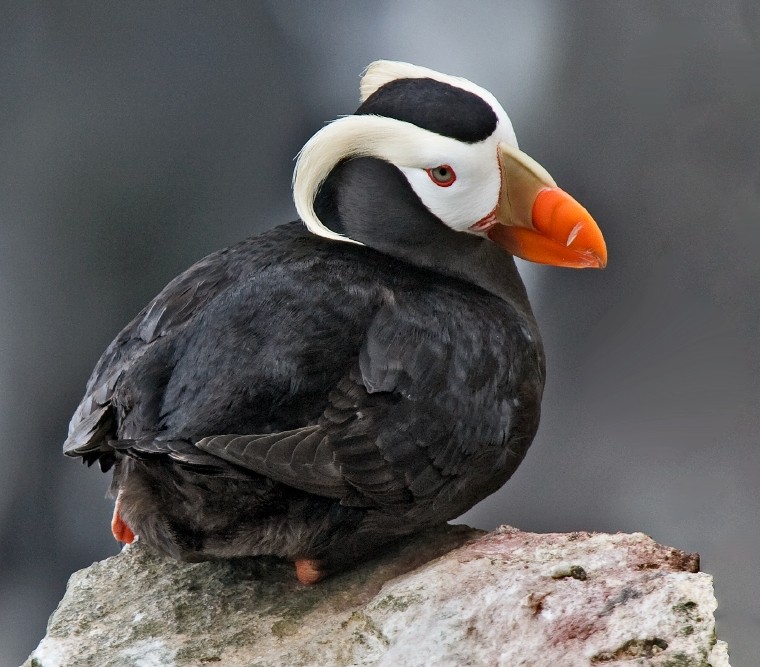Tufted Puffin
A species of Puffins Scientific name : Fratercula cirrhata Genus : Puffins
Tufted Puffin, A species of Puffins
Botanical name: Fratercula cirrhata
Genus: Puffins
Content
Description General Info
 Photo By Alan D. Wilson , used under CC-BY-SA-3.0 /Cropped and compressed from original
Photo By Alan D. Wilson , used under CC-BY-SA-3.0 /Cropped and compressed from original Description
Tufted puffins are around 35 cm (14 in) in length with a similar wingspan and weigh about three quarters of a kilogram (1.6 lbs), making them the largest of all the puffins. Birds from the western Pacific population are somewhat larger than those from the eastern Pacific, and male birds tend to be slightly larger than females. They are mostly black with a white facial patch, and, typical of other puffin species, feature a very thick bill which is mostly red with some yellow and occasionally green markings. Their most distinctive feature and namesake are the yellow tufts (Latin: cirri) that appear annually on birds of both sexes as the summer reproductive season approaches. Their feet become bright red and their face also becomes bright white in the summer. During the feeding season, the tufts moult off and the plumage, beak and legs lose much of their lustre. As among other alcids, the wings are relatively short, adapted for diving, underwater swimming and capturing prey rather than gliding, of which they are incapable. As a consequence, they have thick, dark myoglobin-rich breast muscles adapted for a fast and aerobically strenuous wing-beat cadence, which they can nonetheless maintain for long periods of time. Juvenile tufted puffins resemble winter adults, but with a grey-brown breast shading to white on the belly, and a shallow, yellowish-brown bill. Overall, they resemble a horn-less and unmarked rhinoceros auklet (Cerorhinca monocerata). 
Size
39 cm (15.5 in)
Life Expectancy
6-25 years
Nest Placement
Burrow
Feeding Habits
Tufted Puffin predominantly consume small fish, diving up to 360 feet using an underwater flight technique. They also eat invertebrates like squid and crustaceans. While breeding, they forage in groups, bringing multiple fish to chicks. Diet varies seasonally, incorporating lanternfish at night during winter when alone at sea.
Habitat
Tufted Puffin inhabit marine settings, predominantly along rocky shores and island terrains of the northern boreal water region. Their preferred habitats are maritime slopes, island crests, and occasionally coastal cliffs, with a penchant for cool oceanic climates and grassy terrain for burrow nesting. Post-breeding, tufted Puffin dwell over the deep central North Pacific waters.
Nest Behavior
Tufted Puffin excavate burrows together using feet and bills.
Nest Characteristics
Tufted Puffin nests are burrows in seaside cliffs or slopes with dense vegetation, occasionally in rocky crevices or caves. They average 34 inches in length, with a 7.6-inch wide and 7-inch tall entrance. Nests are lined with stems, leaves, grasses, feathers, and algae.
Dite type
Piscivorous
General Info
Feeding Habits
Bird food type
Behavior
Tufted Puffin exhibit a complex range of behaviors, particularly during breeding season. They engage in elaborate courtship rituals including water pursuits, bill-raising, head-jerking, and 'billing' where their vibrant bills and fleshy ornaments are showcased. These displays carry on with nest material presentation and 'landing displays' on land. Tufted Puffin nest both in solitary pairs and colonies, with behaviors like bowing, nibbling, and wing parading strengthening pair bonds. 'Shift changes' at nests involve ritual interactions, while intruders are deterred by assertive posturing and, if needed, males may chase rivals over long distances in the water. Moreover, tufted Puffin partake in communal flights over nesting sites, emphasizing their social nature.
Distribution Area
Tufted puffins form dense breeding colonies during the summer reproductive season from British Columbia, throughout southeastern Alaska and the Aleutian Islands, Kamchatka, the Kuril Islands and throughout the Sea of Okhotsk. While they share some habitat with horned puffins (F. corniculata), the range of the tufted puffin is generally more eastern. They have been known to nest in small numbers as far south as the northern Channel Islands, off southern California. However, the last confirmed sighting at the Channel Islands occurred in 1997. Tufted puffins typically select islands or cliffs that are relatively inaccessible to predators, close to productive waters, and high enough that they can take to the air successfully. Ideal habitat is steep but with a relatively soft soil substrate and grass for the creation of burrows. During the winter feeding season, they spend their time almost exclusively at sea, extending their range throughout the North Pacific and south to Japan and California. 
Species Status
Many rules and regulations have been set out to try to conserve fishes and shorebirds in Puget Sound. The Department of Natural Resources (DNR) of Washington State has created aquatic reserves surrounding Smith and Minor Islands. Over 36,000 acres (150 km) of tidelands and seafloor habitat were included in the proposed aquatic reserve. Not only do these islands provide the necessary habitat for many seabirds such as tufted puffins and marine mammals, but this area also contains the largest kelp beds in all of Puget Sound. In addition, Protection Island reserve has also been off limits to the public to aid marine birds in breeding. Protection Island contains one of the last two nesting colonies of puffins in Puget Sound, and about 70% of the tufted puffin population nests on this island. 